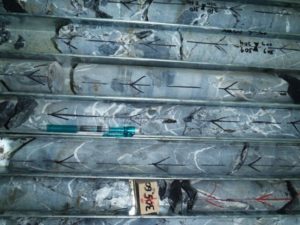Drilling’s Unique Compass
Like an exciting voyage on the open ocean, exploration drilling is an adventure. When breaking through tough formations, reaching impressive depths, or facing challenging geology, there are unique tools that help drillers find their way. Just like a compass at sea, one method has revolutionized it all—core orientation.
What Does "Core Orientation" Mean?
Core orientation has been around since the mid-1800s, a maneuver used, as Shaun Fleming, Major Drilling Operations Manager says, “To define the geological structure, gain geotechnical information, the determining bedding plane, azimuth and inclination the formation is dipping at.” Because core gives a record of underground geology, good drilling companies have perfected how to maximize recovery, yielding samples that are reliable, sound, and expertly excavated.
How We Do It

Core samples with orientation markings. Different line styles show different levels in confidence of the orientation marks used to construct them. Continuous red lines are good quality, broken black lines poor quality. Arrows point in the down-hole direction. Photo and caption credit: www.orefind.com
Geophysical data can only get a driller and geologist team so far. Minerals and rock can fold, dip, or fault. With oriented core data, a more cost-effective and refined approach can be used by using previously cored samples as a guide. Similar to a compass, core orientation points the way and facilitates where to plan and drill the next hole.
Core orientation is beneficial in determining an orebody reserve’s estimate. It also improves mine planning, geotechnical mine design, and safety issues. This method provides data for effective discovery. It is also used for planning and extraction. Each orebody structure has its own complexities. The core orientation process affects estimates of the ore body. The data produced from this process makes core orientation indispensable.
After a drill run is completed, and the core samples come up, drillers are trained to work closely with a geologist to mark the core. In this photo, you’ll notice the core orientation markings with the black arrows indicating the downward-facing hole direction.
“Our customers appreciate how we approach each job as a partnership,” said Fleming. “This helps the geologist and our drillers achieve the continual positive results that set Major Drilling apart in the industry.”
When You Need It
Consider this scenario: You have a property full of commodities and have hired a talented geologist and an innovative team to drill it. The minerals inside the earth that have formed over many thousands of years have developed at a certain angle. Core orientation is key to understanding this unseen, underground position.

Photo Credit: www.orefind.com
Innovations in recent decades have relegated simple vertical hole plunging to the past. Modern tools such as digital core orientation devices help guide the process. With properly applied core orientation methods, more nuanced directional approaches to the geology are possible.
Using core orientation makes exploration drilling more cost effective and more accurate. Core orientation is one of Major Drilling’s area of expertise which adds value to our partnership with client’s geologists. Contact us to find out how to bring our core orientation expertise to your next drilling project.

